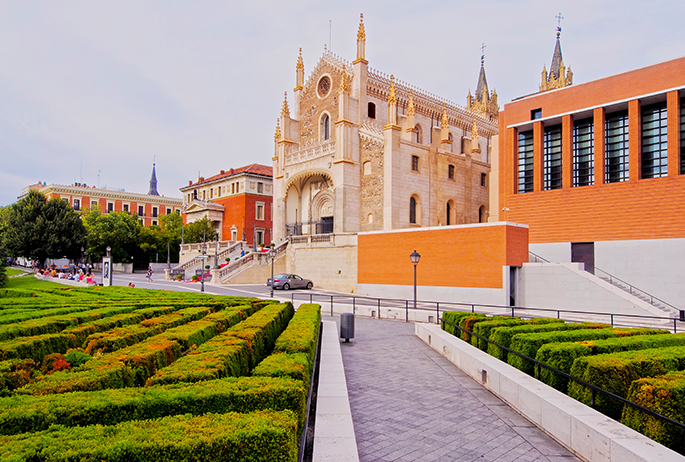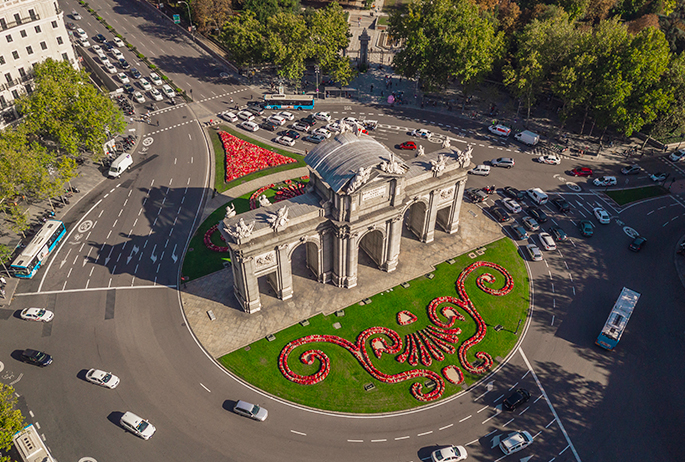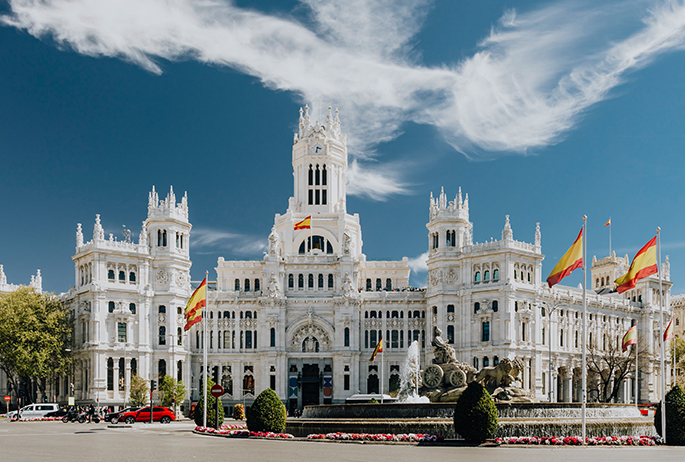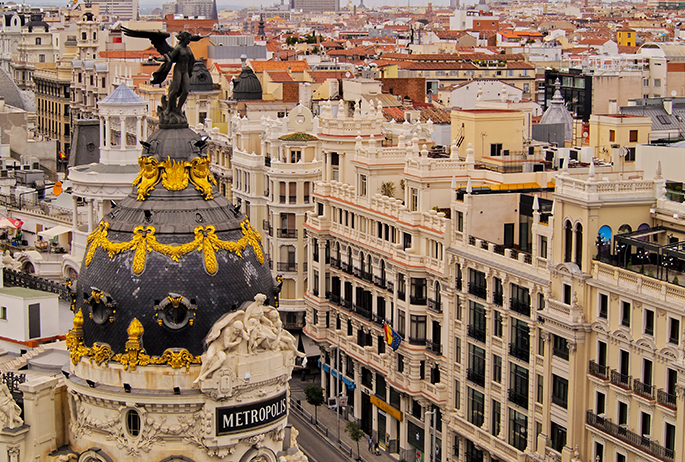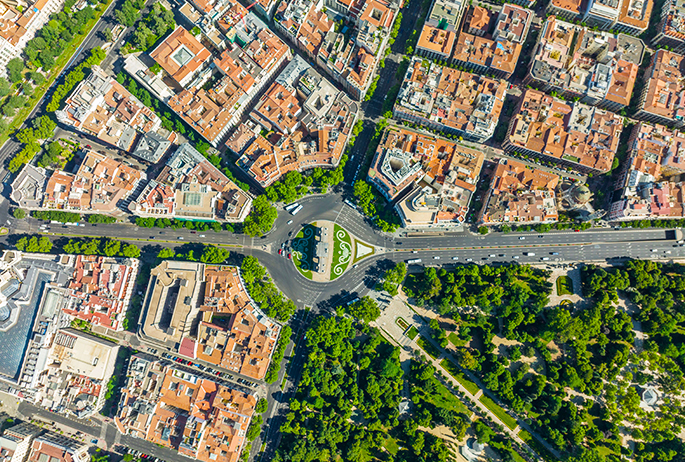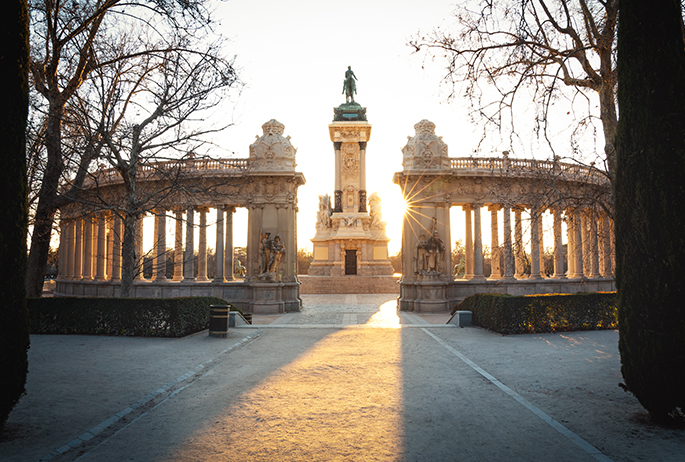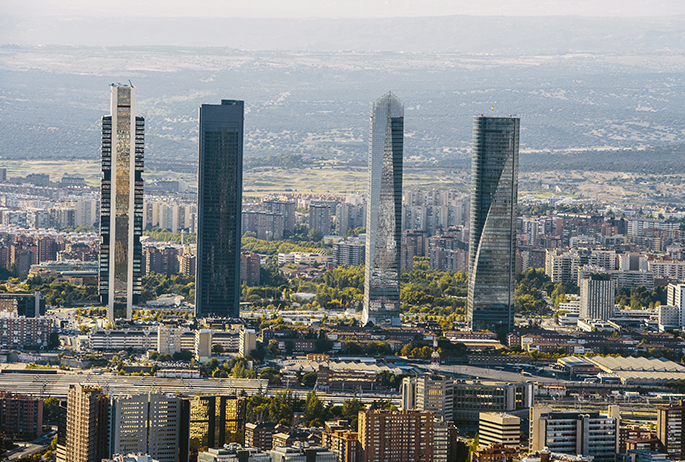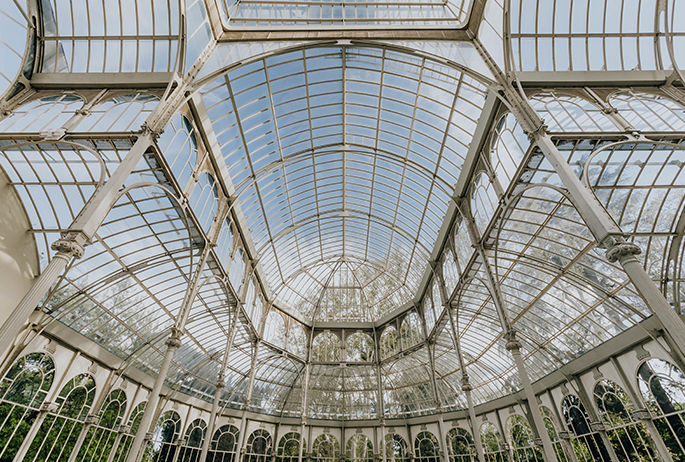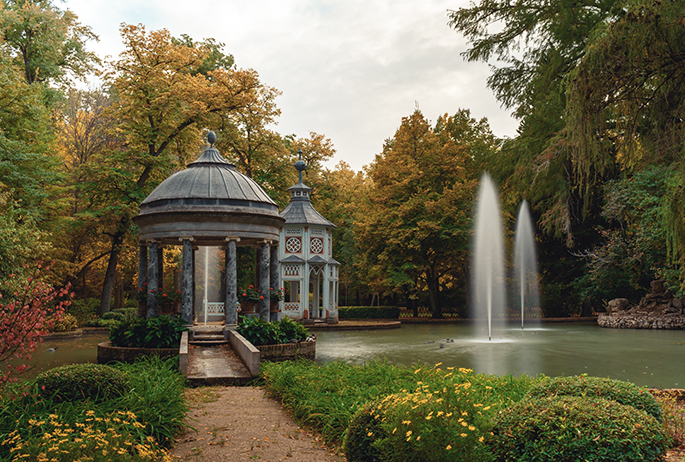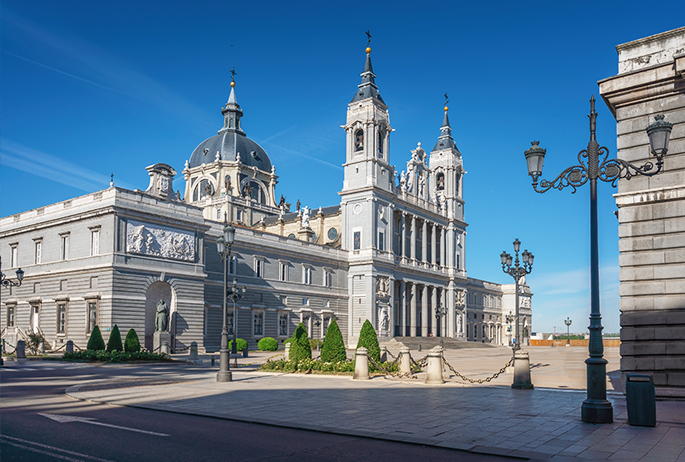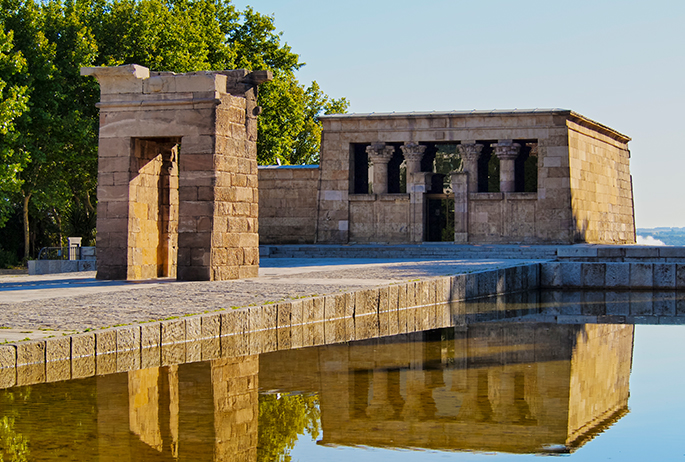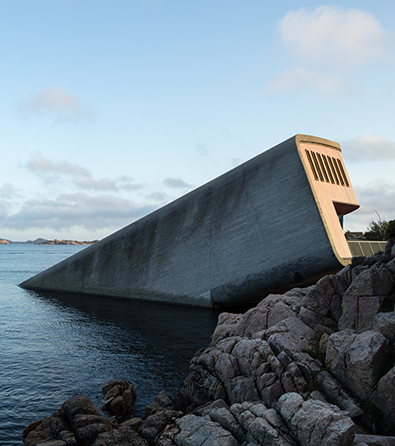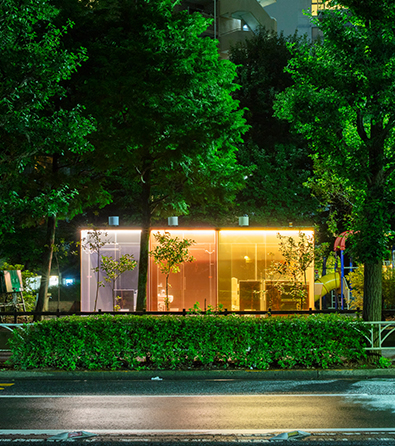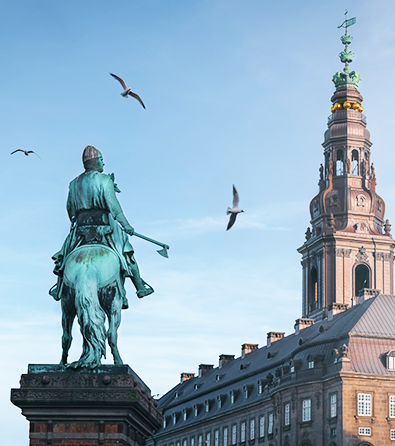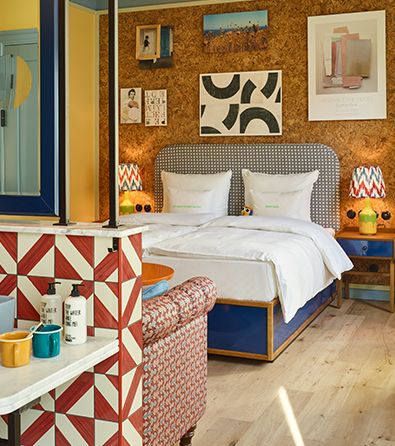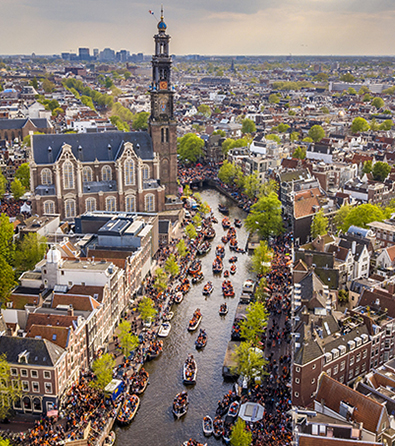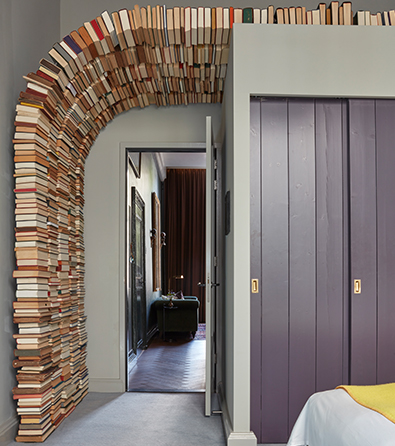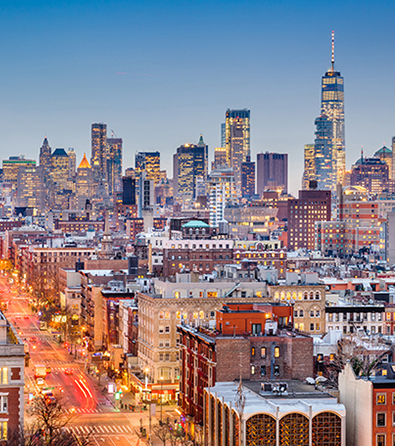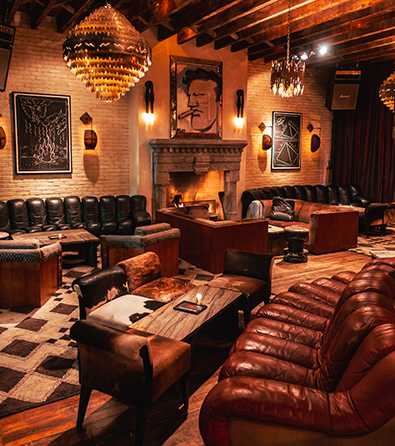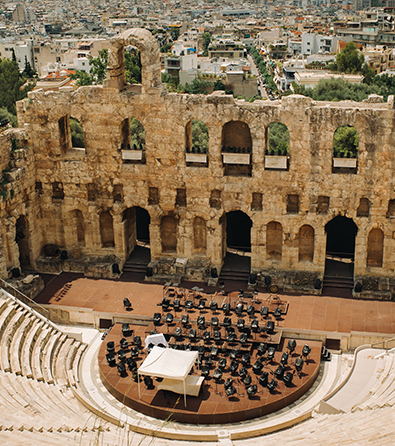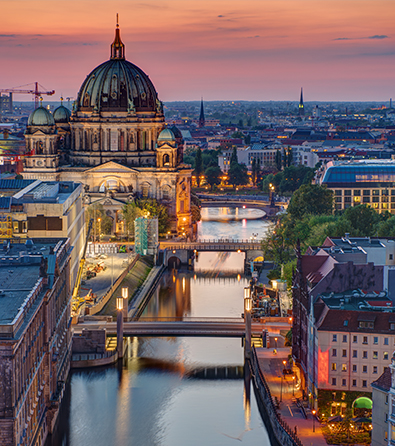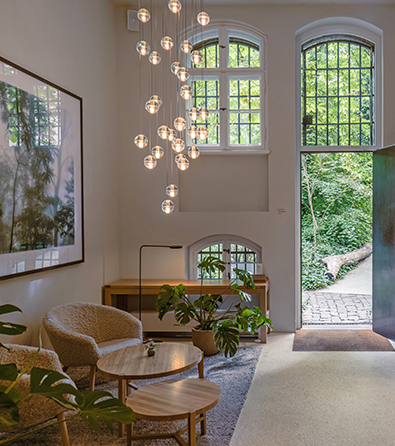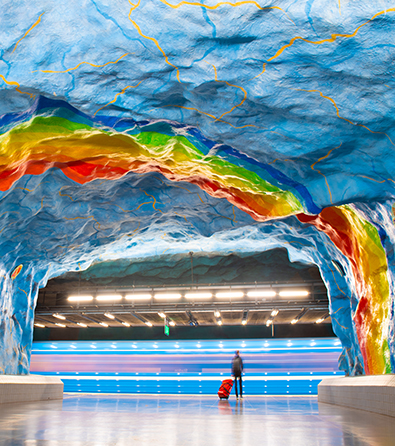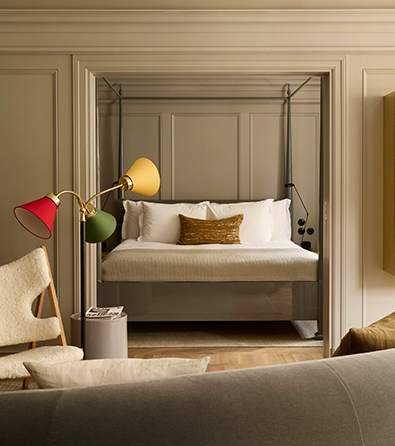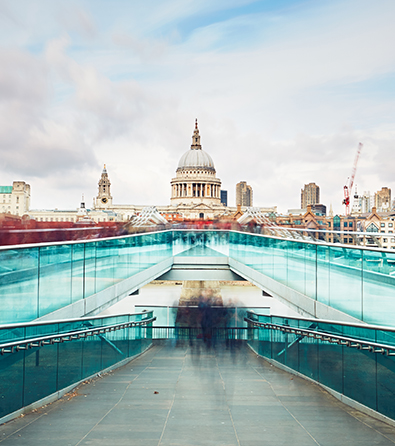Madrid, Spain’s capital, is a city where royal heritage and contemporary creativity converge. Wander from the “Golden Triangle of Art”, home to the Prado, Reina Sofía, and Thyssen-Bornemisza, to the vibrant streets of Malasaña and Lavapiés, where street art, indie galleries, and avant-garde design stores pulse with energy. Whether you’re drawn by masterpieces from Goya and Picasso, modern architecture like Matadero Madrid, or cultural icons like Retiro Park and the Temple of Debod, Madrid invites cultural explorers to discover its layered, dynamic identity..
To access our exclusive Madrid Treasure Map, simply click the attached link and become a Culture Treasures member. The map pins every place in this guide and adds bonus cafés, boutiques and cultural venues. Planning your stay? Discover our top hotels recommendations in Madrid, featured at the end of this guide. For travel gear, explore our urban travel essentials for exploring the city in style, and our long flight essentials to make your journey more comfortable.
Art Museums and Venues:
Museo del Prado (Jerónimos District)
Why go: One of the world’s most important art museums, home to masterpieces by Velázquez, Goya, Bosch, and El Greco.
Tip: Admission is free during the last two hours before closing, daily. To avoid crowds, visit on weekday mornings.
As Spain’s national art museum, the Museo del Prado holds one of the most significant collections of European art, spanning from the 12th to the early 20th century. Founded in 1819 and designed by architect Juan de Villanueva, the museum originally housed works from the Spanish royal collection and has since grown into an international cultural landmark. The Prado is best known for its exceptional holdings of Spanish Golden Age painting, with standout works such as Las Meninas by Diego Velázquez and Francisco de Goya’s haunting Black Paintings, originally painted directly onto the walls of his home. In addition to Spanish masters, the museum features important works by Titian, Rubens, Bosch, and Dürer, offering a rich cross-section of Renaissance and Baroque European art. The neoclassical building, nestled along Madrid’s Paseo del Prado, has undergone several expansions, including the addition of the Jerónimos extension by Rafael Moneo in 2007, enhancing its capacity while preserving its historical integrity.
Museo Reina Sofía (Atocha)
Why go: Spain’s national museum for modern and contemporary art, home to Picasso’s Guernica and works by Dalí and Miró.
Tip: Entry is free on Mondays and Wednesday–Saturday from 7 to 9 p.m., and Sundays from 12:30 to 2:30 p.m.
Housed in a converted 18th-century hospital designed by architect Francisco Sabatini, the Museo Nacional Centro de Arte Reina Sofía is a cornerstone of Spain’s modern art scene. Opened as a museum in 1992, its holdings span from the early 20th century to today, with an emphasis on Spanish artists. The museum’s most iconic work is undoubtedly Pablo Picasso’s Guernica, a monumental and haunting anti-war painting created in response to the bombing of the Basque town during the Spanish Civil War. Other highlights include works by Salvador Dalí, Joan Miró, Juan Gris, and contemporary artists such as Antoni Tàpies and Eduardo Chillida. The museum’s architecture blends historic and contemporary elements, with a striking modern extension by Jean Nouvel added in 2005, which houses temporary exhibitions, a library, and an auditorium. Together, the permanent collection and rotating exhibitions offer a rich narrative of Spain’s turbulent modern history and its vibrant creative output.
CaixaForum Madrid (Paseo del Prado)
Why go: A striking cultural venue housed in a former power station, offering cutting-edge exhibitions and multidisciplinary programming.
Tip: Don’t miss the iconic vertical garden by botanist Patrick Blanc at the building’s entrance, it’s one of Madrid’s most Instagrammed spots.
Located just across from the Prado Museum, CaixaForum Madrid is one of the city’s most innovative cultural centers. It occupies the former Central Eléctrica del Mediodía, an early 20th-century power station that was transformed into a landmark of contemporary architecture by the Swiss firm Herzog & de Meuron. The redesign preserved the original brick façade while adding dramatic elements like a suspended upper floor and a steel-and-glass canopy. Inside, the center hosts a dynamic program of temporary exhibitions spanning modern and contemporary art, photography, design, and science, often in collaboration with major international institutions. Managed by the “la Caixa” Foundation, the venue also includes a concert hall, lecture spaces, workshops, and a bookstore. Its vertical garden, a living wall of over 15,000 plants, is a highlight of the exterior and exemplifies CaixaForum’s mission to blend art, nature, and innovation in a single cultural experience.
Matadero Madrid (Arganzuela)
Why go: A cutting-edge cultural complex housed in a former slaughterhouse, now one of the city’s most creative and multidisciplinary spaces.
Tip: Visit the Cineteca for documentary screenings or explore Casa del Lector for literary-focused exhibitions and programming.
Located along the banks of the Manzanares River in the Arganzuela district, Matadero Madrid is one of the city’s most ambitious urban regeneration projects. The site was originally built between 1911 and 1925 as a municipal slaughterhouse and livestock market, designed by architect Luis Bellido in the Neo-Mudéjar industrial style. After its closure in 1996, the city transformed the complex into a sprawling center for contemporary creation, officially opening in 2007 under the direction of Madrid’s Department of Arts.
Matadero’s expansive grounds now host a wide array of cultural programming across visual and performing arts, literature, film, design, and more. The space retains its industrial identity, with exposed brick façades and repurposed warehouses that serve as creative labs. Key venues include Naves del Español (for theater and performance), Cineteca Madrid (Spain’s first cinema dedicated almost exclusively to non-fiction film), Central de Diseño (a hub for contemporary Spanish design), and Casa del Lector (an international center for reading and literary research). From artist residencies and experimental installations to book fairs and outdoor events, Matadero Madrid remains a vital engine of cultural production and public engagement.
Medialab Prado (Las Letras / Paseo del Prado)
Why go: A hub for digital culture and collaborative innovation, blending art, technology, and civic participation.
Tip: Check their website or program calendar in advance, many workshops and exhibitions require pre-registration and are hands-on.
Medialab Prado is one of Madrid’s most forward-thinking cultural institutions, dedicated to digital culture, open innovation, and participatory creation. Originally launched in 2000 as part of Madrid’s Arts Department, the institution found its permanent home in 2013 in the Serrería Belga (Belgian Sawmill), a historic industrial building from the early 20th century. The structure was extensively renovated by the award-winning architecture firm Langarita-Navarro Arquitectos, who preserved the original brick façade while adding bold contemporary elements like steel walkways and glass volumes, creating a dynamic space that mirrors the institution’s mission.
Unlike traditional museums or cultural centers, Medialab Prado invites visitors not just to view art or innovationת but to actively participate. It hosts a constantly evolving program of workshops, hackathons, exhibitions, and collaborative labs, emphasizing the early-stage development of ideas. The focus spans fields such as open-source technology, data visualization, civic tech, design, sound art, and education. Visitors can join ongoing projects, propose their own, or interact with experimental works. Whether you’re an artist, coder, researcher, activist, or simply curious, Medialab Prado provides an open platform for interdisciplinary exchange that reflects the future of cultural engagement.
La Casa Encendida (Lavapiés / Embajadores)
Why go: A cultural center where contemporary art meets social and environmental consciousness.
Tip: Don’t miss the rooftop terrace, especially in summer, it hosts concerts, film screenings, and DJ sessions with views of the Madrid skyline.
La Casa Encendida is one of Madrid’s most dynamic cultural centers, known for its bold programming that merges contemporary art, social innovation, education, and sustainability. Opened in 2002 by the Montemadrid Foundation, the center occupies a striking neo-Mudéjar building dating back to 1913, originally designed as a banking institution. Its elegant brick façade and interior courtyard have been reimagined into a vibrant, accessible space for cultural exchange.
The venue offers an eclectic year-round program of art exhibitions, concerts, theater performances, film screenings, and educational courses, often with a strong emphasis on social justice, climate action, and emerging creative voices. It has become a leading platform for both local and international contemporary artists, particularly those working across disciplines or addressing urgent global issues. Beyond the galleries and auditoriums, La Casa Encendida features a media library, classrooms, and laboratories, encouraging active community engagement.
A special highlight is its rooftop terrace, which transforms into a lively cultural space during warmer months, hosting open-air cinema nights, DJ sessions, and performance art under the stars. The combination of historic architecture, social programming, and a welcoming atmosphere makes La Casa Encendida a cornerstone of Madrid’s contemporary cultural scene.
La Tabacalera (Lavapiés)
Why go: A grassroots cultural space blending urban art, activism, and community-driven creativity in a historic tobacco factory.
Tip: Look out for temporary exhibitions and live events, and take time to explore the murals of the adjoining street art tunnel.
La Tabacalera de Lavapiés is a fascinating self-managed cultural center housed in the former Fábrica de Tabacos de Embajadores, a neoclassical industrial building dating back to the 18th century. Originally a royal tobacco factory, the building was declared a Property of Cultural Interest and partially repurposed into a cultural venue in the early 2000s. While part of the building is managed by the Spanish Ministry of Culture as the Promoción del Arte exhibition space, the most compelling section is run autonomously by local collectives under the name La Tabacalera de Lavapiés (CSOA Tabacalera).
The space serves as a laboratory for experimentation, collective art projects, and sociopolitical engagement, offering workshops, concerts, exhibitions, performances, and community-led events. Artists and activists converge in its cavernous halls, graffiti-covered tunnels, and improvised galleries, fostering a radically inclusive and experimental atmosphere. The building’s raw, urban aesthetic is preserved, with its exposed brick, industrial fittings, and sprawling indoor street art displays giving it an edge unmatched by conventional institutions.
The surrounding Lavapiés neighborhood complements the spirit of La Tabacalera, with its multicultural identity, affordable eateries, and renowned street art corridor just outside the venue. Murals by local and international artists turn the area into an open-air gallery, reinforcing the strong link between the community and contemporary urban culture.
Contemporary Art Galleries:
Galería Juana de Aizpuru (Justicia)
Founded in 1970 in Seville and relocated to Madrid in 1983, this gallery is one of Spain’s most influential. Juana de Aizpuru was instrumental in establishing ARCOmadrid and has represented Spain at the Venice Biennale. The gallery focuses on conceptual and avant-garde contemporary art and regularly exhibits at Art Basel.
Galería Helga de Alvear (Justicia / Calle Doctor Fourquet)
Owned by German-born collector Helga de Alvear, this gallery has been pivotal in introducing international contemporary art to Spain. Known for bold and multidisciplinary exhibitions, it reflects Alvear’s trailblazing role in the Spanish art scene. Helga de Alvear also founded a museum in Cáceres housing her extensive collection.
Travesía Cuatro (Chueca)
Established in 2003, Travesía Cuatro is a gallery that champions emerging artists from Latin America and Europe. With locations in both Madrid and Guadalajara, Mexico, it bridges transatlantic artistic dialogue and showcases experimental and socially engaged practices.
Galería Elvira González (Salamanca)
Founded in 1994, this gallery represents key figures of 20th- and 21st-century art, including Rothko, Calder, Tàpies, and Serra. It places emphasis on American and European abstraction and is known for its museum-quality exhibitions.
Galería Elba Benítez (Justicia)
Since 1990, Elba Benítez has been showcasing contemporary artists working in diverse media including sculpture, video, installation, and photography. The gallery is internationally active and has participated in fairs such as Art Basel and Frieze.
Galería Max Estrella (Justicia)
Founded in 1994, Max Estrella presents a mix of emerging and established artists, both Spanish and international. The gallery is known for its innovative programming and commitment to contemporary discourse, including multimedia and conceptual art.
NF / Galería Nieves Fernández (Chamberí)
Founded in 1977, this gallery focuses on conceptual, minimal, and socially engaged art. It supports both Spanish and international artists and is known for its sharp curatorial approach and frequent collaborations with cultural institutions.
Mad is Mad (Chueca / Justicia)
A dynamic gallery with a focus on emerging Spanish artists across disciplines like painting, sculpture, and video. Mad is Mad is also notable for its unconventional exhibition layout and dedication to younger audiences and experimental practices.
Design Venues:
Museo Nacional de Artes Decorativas (Jerónimos / Retiro area)
Why go: A beautifully curated museum dedicated to centuries of craftsmanship, offering a deep dive into the evolution of decorative arts in Spain and beyond.
Tip: Don’t miss the recreation of historic interiors, including an exquisite 18th-century Valencian kitchen and Moorish-style rooms.
Founded in 1912, the Museo Nacional de Artes Decorativas is one of Madrid’s oldest and most underappreciated cultural gems. It houses a remarkable collection of over 70,000 objects spanning from the medieval period to the early 20th century, with a strong emphasis on Spanish artisanal traditions and cross-cultural influences. The museum was originally inspired by the Victoria & Albert Museum in London and aims to preserve and promote applied arts and design.
Set across several floors of a stately 19th-century townhouse, the museum displays intricately designed objects including ceramics, glassware, furniture, textiles, jewelry, and interior décor. These are arranged both thematically and historically, offering insight into techniques, materials, and evolving tastes over time. Among the highlights are Mudejar ceilings, Islamic-influenced tilework, Chinoiserie, and Spanish Baroque furniture. A standout feature is the reconstructed Valencian kitchen from the 18th century, with authentic ceramic tiles and cooking implements, which immerses visitors in the domestic life of the period.
Museo ICO (Barrio de las Letras / Paseo del Arte)
Why go: A must-visit for lovers of architecture and urban design, with rotating exhibitions that merge architecture, photography, and visual culture.
Tip: Pair your visit with a stroll through the adjacent Calle de las Huertas or combine with nearby CaixaForum and Museo del Prado.
Museo ICO is one of Madrid’s most distinctive cultural venues, uniquely dedicated to architecture, urbanism, and contemporary visual culture. Operated by the ICO Foundation (Fundación ICO), the museum occupies a renovated neo-Mudejar building just steps from Paseo del Prado and was inaugurated in its current format in 1996. Rather than maintaining a permanent collection, Museo ICO hosts temporary exhibitions curated around themes of city life, architectural thought, and public space, often with a strong photographic or documentary focus.
The museum is particularly known for its interdisciplinary lens, often bridging architecture with graphic arts, illustration, and photography, making it a compelling stop not just for design professionals but for anyone curious about how cities are shaped and experienced. While modest in scale, the space is beautifully organized and includes free admission, making it an accessible and enriching destination within Madrid’s “Golden Triangle of Art.” Its educational programming, in collaboration with architecture schools and cultural institutions, further reinforces its role as a hub for critical reflection on the built environment.
ABC Museum of Drawing and Illustration (Malasaña / Conde Duque)
Why go: A one-of-a-kind museum in Madrid showcasing the evolution of drawing and illustration from the 19th century to today.
Tip: Located near Conde Duque Cultural Center, combine both for a deep dive into visual arts and contemporary culture.
The ABC Museum of Drawing and Illustration (Museo ABC de Dibujo e Ilustración) offers a rare focus on the disciplines of illustration, editorial art, and drawing, fields often overlooked in traditional museum collections. Opened in 2010, the museum is home to the ABC Collection, a historic archive of over 200,000 original works that spans from the late 19th century to the present. These include editorial illustrations, cartoons, comics, graphic art, and magazine covers, originally commissioned by Spain’s ABC newspaper and Blanco y Negro magazine.
The museum is housed in the former Mahou beer brewery, an industrial building originally designed by José López Salaberry, a key figure in early 20th-century Madrid urbanism. The adaptive reuse of the site, led by Aranguren & Gallegos Arquitectos, blends preserved elements of the historic structure with a sleek contemporary design. Features like the glass-floored atrium, angular gallery spaces, and light-filled rooftop turn the museum itself into a striking architectural experience.
Beyond its permanent archive, the ABC Museum hosts rotating temporary exhibitions that spotlight both established and emerging illustrators. Its programming includes workshops, lectures, and educational initiatives, making it a hub for both professionals and curious visitors interested in visual storytelling, print history, and design. Located in the vibrant Malasaña–Conde Duque district, it is a short walk from other cultural venues, trendy cafés, and creative studios.
Espacio Fundación Telefónica (Gran Vía / Centro)
Why go: Explore cutting-edge exhibitions at the crossroads of art, technology, and digital culture, inside one of Madrid’s most iconic early skyscrapers.
Tip: Don’t miss the permanent exhibition on the history of telecommunications—perfect for families, tech enthusiasts, and design lovers alike.
Located in the historic Telefónica Building, Espacio Fundación Telefónica is a vibrant cultural hub that explores the convergence of technology, design, and society. The Telefónica Building itself is a landmark: designed by Luis Ignacio de Cárdenas, it was built between 1926 and 1929 and completed in 1930, drawing inspiration from Manhattan’s early skyscrapers. It is considered one of the first skyscrapers in Europe, standing as a symbol of early 20th-century architectural ambition, blending American verticality with Spanish Baroque elements.
Since opening in 2012, Espacio Fundación Telefónica has become one of Madrid’s most forward-thinking cultural venues. Its temporary exhibitions span topics like digital art, artificial intelligence, data visualization, virtual reality, and interactive media, offering immersive and thought-provoking experiences that reflect on how technology shapes human experience. It also regularly features collaborations with international artists and technologists.
The venue includes a permanent exhibition on the history of telecommunications, tracing the evolution of communication technologies from the telegraph and early telephones to the internet age. Educational programs, lectures, and workshops invite both adults and children to explore technological innovation in engaging and accessible ways.
Located just steps from Gran Vía, this space is a must for those curious about the impact of digital transformation on culture and society, all housed in a historically significant and beautifully restored architectural gem.
La Fábrica (Barrio de Las Letras / Centro)
Why go: A must-visit cultural hotspot for photography lovers and art book collectors, with regular exhibitions, talks, and a curated bookstore.
Tip: Check their website or social media for artist talks and book launches that often coincide with major cultural events in Madrid.
Located in the heart of Barrio de Las Letras, La Fábrica is a multidisciplinary cultural center dedicated to contemporary art, photography, design, and publishing. It functions as a hybrid venue: part gallery, part bookstore, part cultural meeting space, and part publishing house. The gallery has a strong focus on photographic art, regularly exhibiting works by leading names such as Marina Abramović, Nobuyoshi Araki, Richard Billingham, Roger Ballen, and Cristina de Middel, alongside promising emerging artists from Spain and abroad.
Beyond exhibitions, La Fábrica serves as the headquarters of the PHotoESPAÑA festival, Spain’s most important photography event, and plays a central role in Madrid’s broader art ecosystem. The space is also known for hosting literary events, artist talks, and public discussions that bring together creatives across disciplines. Its bookstore specializes in art, photography, and design publications, and the venue regularly launches limited-edition art books and monographs under its own publishing imprint.
Take a break:
Mesón del Champiñón (Plaza Mayor)
Located just off Plaza Mayor, this classic tavern has been serving its signature grilled mushrooms with chorizo since the 1960s. Founded in 1964, it’s tucked beneath the square’s arcades and maintains a cave-like interior with arched brick ceilings and cast-iron décor. A longstanding favorite for tapas enthusiasts.
Barrutia y el 9 (Chueca)
Tucked away on Calle de San Bartolomé, this century-old tavern blends the feel of a neighborhood bodega with inventive interpretations of Spanish home cooking. Despite its rustic interior, the menu is known for seasonal ingredients and contemporary flair.
Taberna La Concha (La Latina)
This cozy, family-run tapas bar sits along Calle Cava Baja, one of Madrid’s most iconic streets for tapas hopping. Known for its vermouth on tap and generous small plates, La Concha blends tradition with warmth and authenticity.
La Mallorquina (Puerta del Sol)
A Madrid institution since 1894, La Mallorquina occupies a corner of Puerta del Sol with large windows overlooking the bustling plaza. Famed for its napolitanas (chocolate- or cream-filled pastries) and traditional roscones, it’s a must-stop for sweet treats and a dose of Belle Époque charm.
Chocolatería San Ginés (Sol)
Founded in 1894, San Ginés is a historic café just off Calle Arenal, beloved for its thick hot chocolate and crispy churros. Open 24/7, the marble-tabled interior preserves its 19th-century ambience and remains a beloved late-night stop for locals and tourists alike.
Café de la Luz (Malasaña)
Located on Calle de la Puebla, this charming café features mismatched vintage furniture, bookshelves, and warm lighting, creating a relaxed atmosphere ideal for a slow breakfast or afternoon coffee in the heart of Malasaña.
Flamenco Venues in Madrid
Corral de la Morería (La Latina)
Opened in 1956, this is Madrid’s most prestigious flamenco tablao. Known for hosting the most acclaimed dancers and musicians in the world, the venue also features a Michelin-starred kitchen. The intimate setting and elegant service make it a refined cultural experience.
Las Carboneras (Austrias)
This modern tablao, situated in the basement of the 17th-century Palacio del Conde de Miranda, blends traditional flamenco with avant-garde performance. Its proximity to Plaza Mayor and its cozy ambiance make it a favorite among locals and connoisseurs.
Tablao Flamenco Torres Bermejas (Gran Vía)
Famous for its intricate interior, inspired by the Alhambra’s Moorish architecture, this tablao has been hosting top-tier flamenco since 1960. With walls covered in geometric tiles and carved wooden ceilings, the setting alone is worth the visit.
Shopping Delight:
Mestizo Contemporary Store (Chueca)
Located in a bright, minimalist space on Calle Piamonte, Mestizo blends global design with Spanish craftsmanship. The store features a curated selection of contemporary furniture, lighting, ceramics, and textiles sourced from artisans and designers around the world. The space itself, set in a former industrial building, maintains an elegant balance between raw and refined.
Kikekeller (Malasaña)
More than just a showroom, Kikekeller is a hybrid design studio, concept store, and cocktail bar. Founded by Kike Keller and Celia Montoya, it showcases limited-edition furniture and objets d’art by local creators. By night, it transforms into a stylish bar, attracting a creative crowd in a setting that blends design and nightlife.
El Moderno Concept Store (Malasaña)
Housed in a corner building on Calle Corredera Baja de San Pablo, El Moderno offers a vibrant collection of contemporary home goods, stationery, fashion accessories, and art prints. The store features both Spanish and international brands and often hosts pop-ups and exhibitions supporting local design talent.
Rughara (Malasaña)
This eclectic concept store on Calle Corredera Alta de San Pablo is known for its bold, colorful interiors and offbeat product curation. From indie fashion and handmade jewelry to art books and quirky homeware, Rughara celebrates emerging designers and sustainable creativity in a highly Instagrammable space.
Ecoalf (Justicia / Salamanca)
Founded in Madrid, Ecoalf is a leader in sustainable fashion, with flagship stores on Calle de Hortaleza and Calle Claudio Coello. The brand is known for using recycled materials like ocean plastics and post-consumer textiles to create sleek, minimalist clothing and accessories. Its stylish stores reflect the brand’s ethos with clean, modern interiors and environmental messaging.
Libros para un Mundo Mejor (Malasaña)
This intimate bookstore on Calle Espíritu Santo offers a handpicked selection of socially engaged literature, poetry, and children’s books. With its cozy interior, warm lighting, and community bulletin board, the space functions as both a literary hub and a haven for reflection and activism through reading.
Vintage delight:
El Rastro (La Latina / Embajadores)
Madrid’s largest and most iconic open-air flea market, El Rastro takes place every Sunday and public holiday from around 9:00 am to 3:00 pm. Spread across the Ribera de Curtidores and adjacent streets, it offers everything from antiques, vintage clothing, and vinyl records to handmade crafts and curiosities. The market has been a fixture of Madrid life since the 18th century.
El Rincón de Tía Jo (Malasaña)
A cozy, well-known vintage shop located on Calle del Espíritu Santo, El Rincón de Tía Jo specializes in retro fashion, accessories, and nostalgic memorabilia. You’ll find unique items like old-school sneakers, costume jewelry, and even vinyl records, all curated with a playful eye.
Williamsburg Vintage (Malasaña)
This boutique offers a sharp, curated selection of vintage clothing and accessories, with an emphasis on mid-century style and Americana. Located on Calle Velarde, it’s a popular stop for fashion lovers looking for statement pieces in excellent condition.
La Recova (Chueca)
Situated on Calle Belén, La Recova is a beautifully staged vintage shop offering antique furniture, decorative objects, and lighting. Items include restored mirrors, baroque-style chairs, and collectible ceramics, often displayed in artistic vignettes within the shop.
Retro City (Malasaña)
This charming store on Calle de la Palma is a haven for design lovers, featuring a selection of 1950s–1980s furniture, vintage lighting, and home decor. The pieces are sourced primarily from Spain and Italy, with a focus on retro-modernist aesthetics.
And Beyond:
Malasaña District (Centro)
Why go: The birthplace of Madrid’s countercultural movement and one of the city’s liveliest neighborhoods for nightlife, street art, and independent design.
Tip: Visit during the Malasaña Festival or stop by Bar Penta and Madrid Me Mata to experience the area’s musical heritage.
Malasaña is one of Madrid’s most iconic neighborhoods, blending historic charm with contemporary urban culture. Known for its central role in the Movida Madrileña, the cultural and artistic awakening that followed the end of Franco’s dictatorship in the late 1970s, Malasaña was a hub for rebellious creativity, inspiring a generation of artists, musicians, filmmakers, and designers. Named after the Spanish heroine Manuela Malasaña, the district remains a symbol of freedom and self-expression.
Today, Malasaña’s narrow streets and plazas are lined with vintage shops, independent fashion boutiques, creative studios, and tattoo parlors. It’s also one of Madrid’s premier nightlife destinations, with trendy bars, intimate clubs, and live music venues that stay open until the early hours. Historic venues like Bar Penta, Via Láctea, and Madrid Me Mata serve as living testaments to the neighborhood’s rock-and-roll spirit, with the latter even functioning as a mini-museum of Madrid’s nightlife history.
The area’s architecture reflects a mix of eras, with 19th-century buildings repurposed into art galleries and co-working spaces. Colorful murals and street art adorn many façades, adding a vibrant visual texture that changes frequently. Throughout the year, Malasaña hosts events such as the Malasaña Market and the Malasaña Festival, spotlighting local designers, artisans, and performers. For anyone interested in the pulse of Madrid’s creative and alternative scene, Malasaña is an unmissable stop.
Las Ventas Bullring (Salamanca / Guindalera)
Why go: A monumental icon of Spanish architecture and bullfighting heritage, Las Ventas is a must-visit for anyone interested in the cultural history of Spain.
Tip: Explore the arena with a guided tour to access the bullring, stands, museum, and chapel. Combine with a visit to nearby Parque de las Avenidas or the lively Calle Alcalá.
Las Ventas, officially known as Plaza de Toros de Las Ventas del Espíritu Santo, is the most famous bullfighting arena in Spain and one of the largest in the world. Located in the Guindalera neighborhood of the Salamanca district, it was inaugurated in 1931, following a design by architect José Espeliú, who passed away before the project was completed. The building was finalized by Manuel Muñoz Monasterio, the same architect who later co-designed Real Madrid’s Santiago Bernabéu Stadium.
The structure is a masterpiece of Neo-Mudéjar architecture, a style that draws from Moorish design and was popular in early 20th-century Spain. Constructed with exposed red brick and decorated with hand-painted ceramic tiles, the façade features coats of arms from Spanish provinces. During the Spanish Civil War, Las Ventas was temporarily repurposed as a detention center, and since 1994 it has been recognized as a Bien de Interés Cultural (Heritage Site). While bullfighting remains a central attraction during the San Isidro Festival and throughout the season, the venue has also diversified in recent years, hosting concerts, exhibitions, and sporting events. Las Ventas is open year-round and offers audio-guided and in-person tours in multiple languages, allowing visitors to explore the arena floor, stands, museum, and chapel.
The Crystal Palace (Palacio de Cristal, Retiro Park)
Why go: A breathtaking example of 19th-century glass and iron architecture, nestled within Madrid’s most iconic park.
Tip: Entry is free, and exhibitions rotate regularly, visit in the afternoon for beautiful light streaming through the glass and a scenic stroll by the lake.
The Crystal Palace, or Palacio de Cristal, is one of Madrid’s most beloved architectural landmarks, situated within the expansive Retiro Park (Parque del Buen Retiro). Designed by Ricardo Velázquez Bosco and completed in 1887, the palace was initially built as a greenhouse to display Philippine flora for the Exposición General de las Islas Filipinas, a colonial exhibition aimed at reinforcing Spain’s imperial relationship with the Philippines.
The building is constructed primarily of glass and wrought iron, anchored on a brick base decorated with ceramic tiles, and is shaped like a Greek cross. Its central dome rises to over 22 meters, creating a striking vertical element that adds to its airiness and grandeur. The design was inspired by London’s Crystal Palace, but the Madrid version has become an icon in its own right, blending industrial materials with elegant proportions. The palace sits beside a small artificial lake, where visitors can often spot ducks, geese, and black swans. Today, it is part of the Museo Reina Sofía and functions as an exhibition space for site-specific installations and contemporary art.
Madrid Design Festival (Annual, February-March)
Why go: One of Spain’s leading design events, spotlighting both international and local talent across multiple creative disciplines.
Tip: The main exhibitions and conferences often require registration or tickets—check the schedule early to reserve your spot.
The Madrid Design Festival is a city-wide, multidisciplinary celebration held annually throughout February and into early March, transforming Madrid into a vibrant hub of contemporary design. Since its launch in 2018, the festival has established itself as one of the most important design events in Spain, offering a platform for dialogue across disciplines such as product design, architecture, graphic design, interior design, fashion, and digital innovation.
Organized by La Fábrica, the same institution behind PHotoEspaña, the festival includes a rich mix of exhibitions, installations, conferences, and workshops, held across leading museums, galleries, design studios, and public spaces throughout the city. Two of the standout programs include:
DesignPRO – a series of professional talks, presentations, and networking events that bring together influential designers and thought leaders from around the world.
OFF Festival – a satellite program highlighting independent showrooms, boutiques, creative studios, and alternative venues throughout Madrid, reinforcing the city’s grassroots design scene.
The festival’s mission is to position Madrid as a capital of design, fostering collaboration between creative disciplines while also addressing broader social themes such as sustainability, social innovation, and urban living.
Metropolis Building (Gran Vía & Calle de Alcalá)
Why go: One of Madrid’s most iconic landmarks, admired for its Beaux-Arts architecture and richly symbolic decorative details.
Tip: For the best photos, visit at sunset when the building’s golden dome glows against the changing sky.
The Metropolis Building is a celebrated architectural jewel that marks the intersection of Gran Vía and Calle de Alcalá, two of Madrid’s most famous thoroughfares. Constructed between 1907 and 1911, it was originally designed by French architects Jules and Raymond Février for the insurance company La Unión y el Fénix. After the company moved, the building was purchased by Metropolis Seguros in 1972, giving the landmark its current name.
The structure is an outstanding example of the Beaux-Arts style, with a richly adorned white stone façade featuring Corinthian columns, intricate balustrades, and allegorical sculptures representing Trade, Agriculture, Industry, and Mining. Its most striking feature is the black slate dome, covered in 24-carat gold leaf, and crowned with a statue of the winged goddess Victoria, installed in 1977 after the original statue of Phoenix and Ganymede was relocated to the company’s new headquarters.
Temple of Debod (Parque del Oeste)
Why go: A rare and beautifully preserved ancient Egyptian temple, right in the heart of Madrid.
Tip: Visit at sunset to see the temple dramatically reflected in the surrounding pools, with panoramic views over Casa de Campo.
The Temple of Debod is one of Madrid’s most surprising and culturally significant landmarks: an authentic 2nd-century BCE Egyptian temple relocated stone by stone from the banks of the Nile. Originally constructed under King Adikhalamani of Meroë and later expanded by Ptolemaic and Roman rulers including Augustus and Tiberius, the temple was dedicated to the gods Amun and Isis.
In 1968, Egypt gifted the temple to Spain in gratitude for its help in saving the Abu Simbel temples during the construction of the Aswan High Dam. The structure was carefully dismantled and transported, then reconstructed in Parque del Oeste, near Plaza de España, with its original east–west orientation preserved. The site opened to the public in 1972.
Today, the temple is surrounded by serene gardens and reflecting pools, offering visitors a peaceful and evocative setting. The park also features a rose garden and panoramic vistas across Casa de Campo. The temple is especially magical at sunset, when it’s illuminated and reflected in the water, making it one of Madrid’s most photogenic and contemplative spots.
With the interactive map below, you can compare all available accommodation options in the city and find the best prices from a variety of leading providers.
